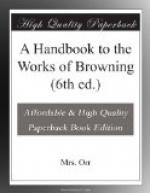The Lyric shows how the Finite may prefigure the Infinite, by illustrations derived from science and from love.
9. “CHERRIES” illustrates the axiom that a gift must be measured, not by itself, but by the faculty of the giver, and by the amount of loving care which he has bestowed upon it. Man’s general performance is to be judged from the same point of view.
The Lyric connects itself with the argument less closely and less seriously in this case than in the foregoing ones. The speaker has striven to master the art of poetry, and found life too short for it. “He contents himself with doing little, only because doing nothing is worse. But when he turns from verse-making to making love, or, as the sense implies, seeks to express in love what he has failed to express in poetry, all limitations of time and power are suspended; every moment’s realization is absolute and lasting.”
10. “PLOT-CULTURE” is a distinct statement of the belief in a purely personal relation between God and man. It justifies every experience which bears moral fruit, however immoral from human points of view; and refers both the individual and his critic to the final harvest, on which alone the Divine judgment will be passed.
The Lyric repeats the image in which this idea is clothed, more directly than the idea itself. A lover pleads permission to love with his whole being—with Sense as well as with Soul.
11. “A PILLAR AT SEBZEVAR” lays down the proposition that the pursuit of knowledge is invariably disappointing: while love is always, and in itself, a gain.
The Lyric modifies this idea into the advocacy of a silent love: one which reveals itself without declaration.
12. “A BEAN-STRIPE: ALSO APPLE-EATING” is a summary of Mr. Browning’s religious and practical beliefs. We cannot, it says, determine the prevailing colour of any human life, though we have before us a balanced record of its bright and dark days. For light or darkness is only absolute in so far as the human spirit can isolate or, as it were, stand still within, it. Every living experience, actual or remembered, takes something of its hue from those which precede or follow it: now catching the reflection of the adjoining lights and shades; now brighter or darker by contrast with them. The act of living fuses black and white into grey; and as we grasp the melting whole in one backward glance, its blackness strikes most on the sense of one man, its whiteness on that of another.
Ferishtah admits that there are lives which seem to be, perhaps are, stained with a black so deep that no intervening whiteness can affect it; and he declares that this possibility of absolute human suffering is a constant chastener to his own joys. But when called upon to reconcile the avowed optimism of his views with the actual as well as sympathetic experience of such suffering, he shows that he does not really believe in it. One race, he argues, will flourish under conditions which another would regard as incompatible with life; and the philosophers who most cry down the value of life are sometimes the least willing to renounce it. He cannot resist the conviction that the same compensating laws are at work everywhere.




